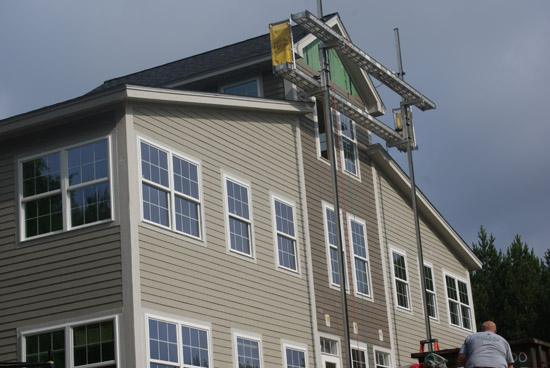Pump Jacks For Siding Installation


Pump Jacks Make Siding Installation Safer
Pump jacks make siding installation much safer and productive. One of our crews recently installed James HardiPlank Lap Siding on a three story addition for a private school with the assistance of pump jacks. You can buy pump jacks from most building supply companies and some online specialty stores.
As you can see in the photo above we were using the pump jacks to access a portion of the building that was 30 feet in the air. Two men can work comfortably from the long span OSHA approved plank system.
We often use the pump jacks for several tasks including:
- Siding
- Windows
- Trim
- Painting
- Roofing
Using Pump Jacks Safely
It’s important that pump jacks are used safely and in accordance with State and Federal safety regulations. If you’re new to pump jacks (or even ladder jacks) you may want to check out a publication that OSHA has prepared:
- Pump Jack/Ladder Jack Scaffold Photo Compliance Guide
Werner Ladder also published a useful summary of pump jack safety references:
The big key is being sure that you or your crew are using all the safety devices. Most pump jack systems come with safety netting, back scaffolding planks, etc to prevent falls and dropped equipment. It’s also VERY important to follow maximum working loads including people, tools and materials.
Using pump jacks has drastically improved our safety and production. Workers feel much more secure while being able to move about more freely. If you don’t use pump jacks you really should consider them. Some rental centers also rent them so that’s an option for home owners looking for a safer way to work on their homes.
Recent Posts
Framing Stick Nailer vs Coil Nailer
Which is Better a Stick Nailer or Coil Nailer? Framers have many choices in nailers…
How Many Roofing Nails Per Square of Shingles
Estimating How Many Nails for a New Roof When it comes to estimating materials for…
Composite / PVC Decking – Layout Tips & Advice
Composite / PVC Decking Layout Tips and Advice Composite and PVC decking have really changed…
Benefits of an ERV System (Energy Recovery Ventilator)
Benefits of ERV Systems (Energy Recovery Ventilator) If you're building a new home or doing…
Vermiculite Attic Insulation Abatement
Vermiculite Attic Insulation If your home was built before 1990 there is a chance it…
Nuisance Tripping of AFCI (Arc Fault) Circuit Breakers
Arc Fault (AFCI) Circuit Breakers Tripping Often An arc-fault circuit interrupter (AFCI) or arc-fault detection…
View Comments
Just thought I'd point out that the photo doesn't appear to show toe boards and mid rails (or a net) so I don't think that the set up as shown is in compliance with OSHA regs.
Mark - Actually OSHA allows this set-up because the distance between platforms is only about 24" (http://www.osha.gov/SLTC/pptpresentations/pumpjack_0398/slides/slide14.html). Also, no toe boards are required in this set-up, again per OSHA site and the pump jack manufactures site. The net is missing because the workers are finished using it and preparing to take it down.
Actually, if you read OSHA: http://www.osha.gov/pls/oshaweb/owadisp.show_document?p_table=STANDARDS&p_id=10752#1926.451%28g%29%284%29%28ii%29
The nets are not specifically required. They only give guidelines for them if you choose to use them. Obviously the nets are quite important especially to protect against falling debris.
Just to be clear, toe boards are not required IF there is a safety net in place, right?
1926.451(h)(2)(ii)
A toeboard shall be erected along the edge of platforms more than 10 feet (3.1 m) above lower levels for a distance sufficient to protect employees below, except on float (ship) scaffolds where an edging of 3/4 x 1 1/2 inch (2 x 4 cm) wood or equivalent may be used in lieu of toeboards;
Mark - Couple things.
1. Neither toe boards and/or nets are required if the area below is barricaded to keep people out 1926.451(h)(2)(i) OR
2. you must meet the requirements of 1926.451 (h)(2)
So basically you can follow either criteria and be within the limits of the regulation.
I love this staging but my question is whdn you put two 24' poles together how do you stand them up
You don't put two 24' together! Not designed for that.
According to Alum-A-Pole's website, these pole jacks are OSHA approved to be used at up to a 50' shoulder work height. Which would include combining 2 24' poles, as stated above. There are instructions on their website explaining how to use a rope system to safely lift such a heavy, long pole.
Here is the information from their site:
b) Alum-A-Pole combinations in
excess of 24' high requires a rope
being employed to hoist the
Alum-A-Pole, as per drawing.
Note that rope is going through “X” juncture
on Alum-A-Brace. This is especially
useful for longer jointed erections and/or
where absolute erection control is less
than 100% i.e., sloped ground, proximity
of electrical wires, etc.
Our biggest issue as a siding contractor is not being able to use the pole jack on top of a roof. There are many applications on residential construction where this is needed, but no hardware is available to safely mount the bottom of a pole to a roof.
We never use aluminum poles for pump Jacks. 2x4s nailed together has always worked fine for use. Only requires a little bit of 2x4 bracing .